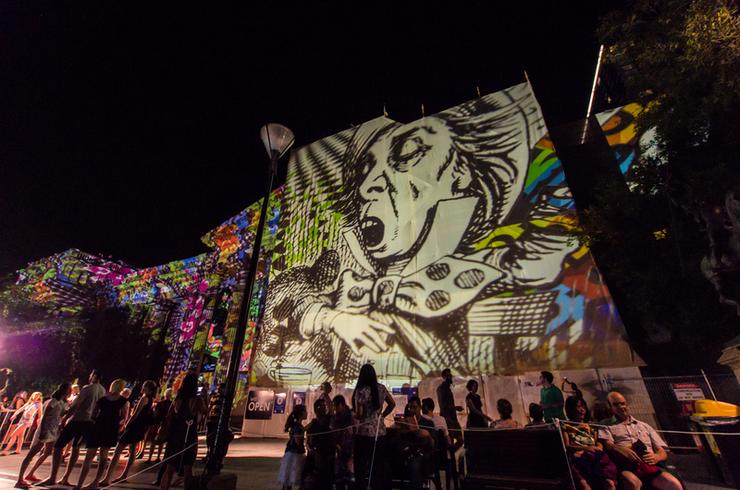
Light projections on the facade of the State Library of Victoria during the White Night overnight arts festival in February 2015.
The State Library of Victoria plans to use virtual and augmented reality technologies to improve the experience for visitors as part of a long-standing program to digitise its assets.
The digitisation program – which has been running since way back in 1990 – received a significant boost last April when the Victorian government announced a five-year, $81.3 million project to redevelop the library.
The government said it would commit $55.3 million to the project with the library kicking in the remaining $28 million through philanthropic contributions.
“We are experimenting with touch technologies, VR and AR, 360 degree video and other technologies. Our aim is to make experiences with our historical collections, and the library more broadly, as immersive, engaging and accessible as possible,” Peter McMahon, director – digital marketing and communications, at The State Library of Victoria, told CIO Australia.
His team is playing with several VR technologies including the Samsung Gear VR, Oculus Rift, and Google Cardboard devices.
“Because this is a four to five year redevelopment project a lot of those technologies are going to change dramatically in that period of time so it’s almost too early to try and pick a winner. It’s a case of watching how each of them evolves and Samsung seems to be racing along,” he said.
The State Library of Victoria adds around 40,000 items to its digitised collection each year – with the earliest digitised image dating back to 1854. It has converted more than 2 million files in digital format including lantern slides, glass negatives, maps, posters, sheet music, and sketchbooks.
The collection takes up 94.8 linear kilometres of storage space, partly onsite and at its custom-built storage facility in Ballarat, Victoria.
The library has recently rigged up a ball shaped 3D-printed cage capable of holding six GoPro cameras, enabling visitors to explore the inside of the library after dark using illuminated projections and soundscapes.
“The rig itself is configured to position each camera that that there is sufficient overlap to enable post-shoot stitching,” said McMahon. “The feed from each camera is then stitched using custom software and outputs as a hybrid Mp4 file.
“Until recently, you would have needed a special viewer to view the Mp4 file in a 360-degree view but both YouTube and Facebook now support native 360 video files, and the YouTube iOs app leverages the iPhone’s gyroscope stabliser to create the more immersive ‘move and look’ experience,” he said.
McMahon said the digitisation program is ongoing and the library won’t be resting on its laurels as technology evolves.
“As each new type of technology emerges, we have to be constantly aware of how we digitise things so we are adopting a make once, use many approach – we digitise as output-agnostic as we possibly can,” he said.
“For instance, when we digitise a handwritten manuscript, we want it to be viewable on the web, we’d like to be able to use it as a virtual book, and ultimately if there’s an opportunity to use it in a VR environment that we can do that aswell,” he said.
“And more and more we are looking to users and patrons to tell us where we should be focusing,” he said. “The notion of picking something that is of particular interest to a community group, for example, and processing those [files and photographs] first is generally a good way to gauge if we are on the right track,” he said.
In November, the library posted online a digitised collection of film strips that were donated to the library in 1977 by the Committee for Urban Action.
These images of streets and houses in the inner suburbs of Melbourne, taken between 1972 and 1975, were taken to create a living record of these old historic suburbs – many of which were in danger of being replaced with high rise public housing.
“There was a concern that these areas were going to make way for the Victorian Housing Commission’s perceived inclination towards high rise public housing and the damage they were going to potentially do to these inner city areas,” he said.
“There were about seven of these [urban action] groups who had quite an effect on public policy because shortly after they started to relocate people into low rise housing.
“It did have a profound social impact. Because we have such a vast collection to choose from – everything we have is historically significant. It’s picking out those things that are going to have broad public appeal and also that demonstrate how social action has changed history over time.”
In 2014, the State Library of NSW spoke about the digitisation of its information assets, which have been created over the past 200 years.
Follow CIO Australia on Twitter and Like us on Facebook… Twitter: @CIO_Australia, Facebook: CIO Australia, or take part in the CIO conversation on LinkedIn: CIO Australia
Follow Byron Connolly on Twitter:@ByronConnolly
Join the CIO Australia group on LinkedIn. The group is open to CIOs, IT Directors, COOs, CTOs and senior IT managers.
